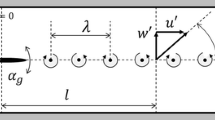Abstract
The design of guide vanes for use in expanding bends was investigated both experimentally and numerically. The primary application in mind is the use of expanding corners in wind-tunnels for the purpose of constructing compact circuits with low losses. To investigate the performance of guide vanes in realistic situations expansion ratios between 1 and 53 were tested in the experiments. These were carried out in an open wind-tunnel specially built for the present purpose. The experimental results demonstrated that suitably designed guide vanes give very low losses and retained flow quality even for quite substantial expansion ratios. For wind-tunnel applications expansion ratios around 1.3 seem appropriate, Optimization of a guide vane design was done using a two-dimensional cascade code, Mises. A new vane optimized for an expansion ratio of 43 gave a two-dimensional total pressure-loss coefficient as low as 0.041 for a chord Reynolds number of 200,000.
Similar content being viewed by others
Author information
Authors and Affiliations
Additional information
Received: 7 April 1997/Accepted: 11 August 1997
Rights and permissions
About this article
Cite this article
Lindgren, B., Österlund, J. & Johansson, A. Measurement and calculation of guide vane performance in expanding bends for wind-tunnels. Experiments in Fluids 24, 265–272 (1998). https://doi.org/10.1007/s003480050173
Issue Date:
DOI: https://doi.org/10.1007/s003480050173



